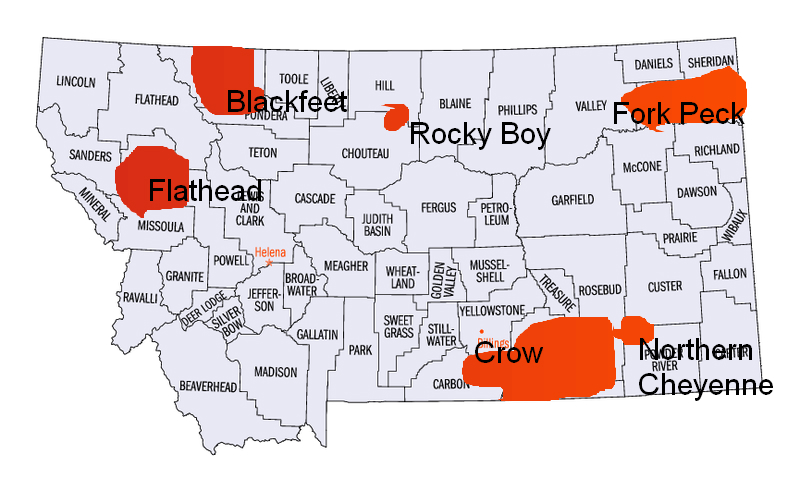Mapping Montana’s Reservations: A Advanced Tapestry of Sovereignty and Battle
Associated Articles: Mapping Montana’s Reservations: A Advanced Tapestry of Sovereignty and Battle
Introduction
With enthusiasm, let’s navigate by the intriguing subject associated to Mapping Montana’s Reservations: A Advanced Tapestry of Sovereignty and Battle. Let’s weave attention-grabbing info and provide contemporary views to the readers.
Desk of Content material
Mapping Montana’s Reservations: A Advanced Tapestry of Sovereignty and Battle

Montana, a state famend for its breathtaking landscapes and wealthy historical past, holds inside its borders a big variety of Native American reservations. These reservations, removed from being homogenous entities, characterize a posh tapestry of cultures, histories, and ongoing struggles for self-determination. Understanding the geography and socio-political realities of those reservations requires greater than a easy look at a map; it necessitates a deeper dive into the historic context, the present challenges, and the colourful cultural heritage that defines every group.
A map of Montana exhibiting the places of its numerous reservations reveals a geographical distribution that displays historic treaties, land cessions, and the persistent affect of colonialism. The reservations aren’t uniformly sized or formed; some are comparatively compact, whereas others are sprawling and geographically fragmented. This fragmentation, typically a results of historic land grabs and damaged treaties, considerably impacts the financial viability and social cohesion of the communities inside them. For instance, the Fort Belknap Indian Group, encompassing each the Fort Belknap and the Little Rocky Mountain areas, demonstrates this fragmentation, with important distances separating its constituent elements.
The Main Reservations: A Transient Overview
Montana hosts seven main federally acknowledged tribes, every with its personal distinctive reservation:
-
The Blackfeet Nation: Occupying an unlimited space in north-central Montana, the Blackfeet Reservation is among the largest within the state. Recognized for his or her wealthy cultural heritage and conventional lifestyle, the Blackfeet Nation faces important challenges associated to poverty, unemployment, and entry to important companies. The reservation’s geography, characterised by plains and mountains, additionally presents logistical hurdles for improvement and infrastructure enhancements.
-
The Crow Nation: Situated in south-central Montana, the Crow Reservation is one other substantial land space with a definite cultural identification. The Crow folks have an extended and sophisticated historical past, together with important involvement in each the fur commerce and numerous conflicts with the US authorities. Like different reservations, the Crow Nation struggles with problems with financial disparity and healthcare entry. The reservation’s various terrain, encompassing grasslands and mountainous areas, presents each alternatives and challenges for financial diversification.
-
The Flathead Nation: Located in northwestern Montana, the Flathead Reservation is dwelling to the Confederated Salish and Kootenai Tribes. This reservation is understood for its gorgeous pure magnificence, together with Flathead Lake, one of many largest pure freshwater lakes west of the Mississippi. Nevertheless, the Flathead Nation additionally grapples with problems with poverty, environmental considerations associated to useful resource administration, and the preservation of its cultural heritage within the face of exterior pressures.
-
The Fort Belknap Indian Group: As talked about earlier, this group contains two distinct bands, the Gros Ventre and Assiniboine, and is geographically fragmented. This fragmentation poses important challenges for governance, financial improvement, and the supply of social companies.
-
The Fort Peck Assiniboine and Sioux Tribes: Situated in northeastern Montana, the Fort Peck Reservation is characterised by its huge measurement and various panorama. The tribes residing right here face comparable challenges to different reservations, together with excessive charges of poverty and unemployment. The reservation’s intensive space additionally presents challenges when it comes to infrastructure improvement and useful resource administration.
-
The Northern Cheyenne Tribe: The Northern Cheyenne Reservation, positioned in southeastern Montana, is a comparatively smaller reservation in comparison with others within the state. The Northern Cheyenne folks have a wealthy historical past and enduring cultural traditions, however in addition they face important challenges associated to poverty, healthcare, and environmental safety.
-
The Rocky Boy’s Indian Reservation: This reservation is dwelling to the Chippewa Cree Tribe of the Rocky Boy’s Reservation. It is a smaller reservation dealing with most of the identical socio-economic challenges as different Montana reservations.
Past the Map: Understanding the Socio-Financial Realities
A map alone can’t absolutely seize the complexities of life on Montana’s reservations. These communities face a large number of interconnected challenges, together with:
-
Poverty and Unemployment: Excessive charges of poverty and unemployment are pervasive throughout Montana’s reservations. Restricted financial alternatives, coupled with historic injustices and systemic discrimination, contribute to this persistent financial hardship. Lack of entry to high quality schooling and job coaching additional exacerbates the state of affairs.
-
Healthcare Disparities: Entry to ample healthcare stays a big problem. Many reservations lack enough medical services and healthcare professionals, leading to poorer well being outcomes in comparison with the non-Native inhabitants. Transportation boundaries and the excessive price of healthcare additionally contribute to this disparity.
-
Environmental Points: The environmental well being of many reservations is compromised by historic contamination, insufficient infrastructure, and the affect of extractive industries. Water high quality, air air pollution, and the disposal of hazardous waste pose important threats to the well being and well-being of reservation residents.
-
Sovereignty and Self-Willpower: The battle for tribal sovereignty and self-determination continues to be a central theme within the lives of Montana’s Native American communities. This includes asserting management over their very own affairs, together with land administration, useful resource improvement, and the administration of justice. The continued negotiation of treaties and the assertion of tribal rights are essential features of this ongoing battle.
-
Training: Entry to high quality schooling is essential for breaking the cycle of poverty and empowering future generations. Nevertheless, many reservations face challenges in offering ample instructional sources, together with funding, certified academics, and related curriculum.
The Significance of Understanding
Understanding the geography and socio-economic realities of Montana’s reservations is essential for addressing the challenges these communities face. A nuanced understanding of the historic context, coupled with a dedication to collaboration and respect for tribal sovereignty, is important for creating significant partnerships and fostering optimistic change. This requires transferring past a simplistic map and interesting with the wealthy cultural heritage, the persistent struggles, and the unwavering resilience of Montana’s Native American communities. Solely by such understanding can we work in the direction of a future the place these communities thrive and their inherent rights are absolutely revered.
Wanting Forward: Alternatives and Challenges
Whereas the challenges are important, there are additionally alternatives for optimistic change. Elevated funding in schooling, healthcare, and infrastructure is essential. Supporting tribal-led financial improvement initiatives, equivalent to tourism, agriculture, and renewable power, can create jobs and enhance the financial well-being of reservation residents. Moreover, strengthening partnerships between tribal governments, state businesses, and federal organizations is important for efficient collaboration and useful resource allocation.
Finally, a complete understanding of Montana’s reservations requires going past the restrictions of a map. It includes partaking with the complicated histories, the continuing struggles, and the colourful cultures of the seven tribes that decision this state dwelling. By acknowledging the previous, addressing current challenges, and embracing the potential for future development, we will work collectively to construct a extra simply and equitable future for Montana’s Native American communities. This requires a sustained dedication to collaboration, respect, and a real understanding of the distinctive wants and aspirations of every tribe. Solely then can we hope to create a Montana the place all its residents, together with its Indigenous populations, can thrive.








Closure
Thus, we hope this text has supplied invaluable insights into Mapping Montana’s Reservations: A Advanced Tapestry of Sovereignty and Battle. We respect your consideration to our article. See you in our subsequent article!